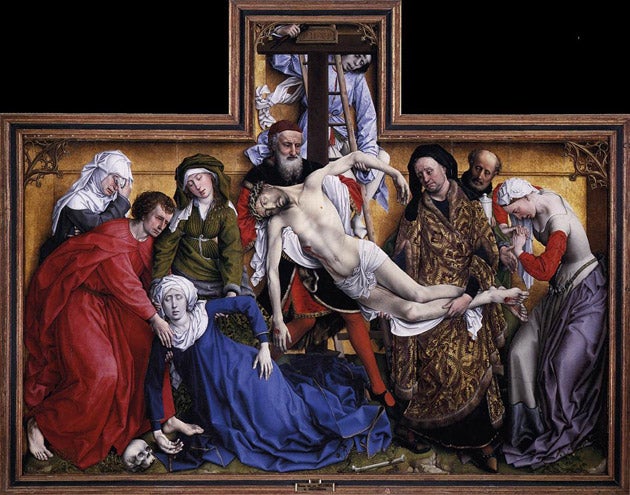Great Works: The Deposition (1436), Rogier Van der Weyden
Prado, Madrid

The principal galleries of the Prado in Madrid, stuffed with their brilliant galaxy of Raphaels, Zurburans, Correggios, Murillos and much else, move in a single great processional sweep, from West to East, down the building.
But the painting we are looking for, which entered the Spanish royal collections in the 16th century, is tucked away in a relatively small side gallery off to the left, and seems surprisingly little trumpeted by its position there, considering its importance in the history of Western art – and its size.
Rogier Van der Weyden's Deposition, painted in 1436 when he was serving as official painter to the town of Brussels, is one of the most dramatic religious paintings ever executed. It deals with matters familiar to those who are conversant with the Christian story. In fact, you could say that what it shows us is almost wearisomely over-familiar – until you examine this particular rendering of the story. Van der Weyden has re-imagined an old theme.
Its moment (and it feels like a very brief moment of telescoped time, into which an overwhelming number of significant events have been condensed) is that lowest of low points in the Christian story when the dead body of Christ the Messiah was removed, and manhandled down from the cross by several hands, like so much lumber. It was a private moment of grief and tragedy for his immediate family, friends and apostles (who are all represented at the scene), and public humiliation for his cause. This man who had spoken of the life everlasting was, after all, so much lifeless flesh and blood, made of the same stuff as the rest of humankind.
Van der Weyden himself, born in Tournai in 1400, was one of the greatest of the so called "Flemish Primitives", that group of painters who worked in the Southern Netherlands during the fifteenth century, and brought to painting a radical new way of treating secular and religious subject matter, an often painfully brutish kind of realism. After serving as painter to the city of Brussels, he moved to Italy. He worked in Rome and Ferrara, where he painted for the Estes and the Medicis. But he never quite surpassed the intensity of this early masterpiece. In fact, later on, his paintings begin to look a trifle formulaic by comparison.
Not so this glorious Deposition – so bald a description for so sumptuous a masterpiece. There is an almost brutal, if not harsh immediacy about the painting. This is religious drama felt on the pulses. The ten large figures, all densely packed within what looks like a shrine, are trapped within a space which measures approximately eight and a half feet by seven. The drama of their outrageous grief seems to burst out of the painting – there is space for nothing else. The entire composition possesses tremendous animation. Bodies twist, turn, almost writhe in agony. The grouping is almost sculpturally plotted. In fact, such is its sense of bulk that it looks and almost feels like sculpture. What is more, this painting, such is its cunning craft, is not a Deposition scene alone. It is also suggestive of other elements of the Passion story. The way in which Christ's arms seem to spread and spread, as if almost reaching out once again for the arms of the cross on which he was crucified, remind us of the Crucifixion. His feet are still crossed, spurting blood, as if nailed to the Cross. The grief of the Virgin Mary, collapsed at the feet of the beloved apostle John, whose hand tries to sustain her, reminds us that this is also a prolonged Lamentation scene for the death of Christ. And the presence of Joseph of Arimathea, the rich, brilliantly bedecked man who allowed his own tomb to be used for the body of Jesus, tells us that this is part way to being a depiction of the Entombment as well.
This compacting of themes within a single theme seems to add to the emotional weight of the painting – as do other acts of replication. Consider the extraordinary shape of the painting, for example. Is it not partially suggestive, albeit in truncated form, of the shape of the cross on which Jesus died? And, yes, we can see that cross too, framed in the uppermost part of the painting. And then notice the fact that both Mary and Jesus are being physically supported and emotionally sustained – by two people. The duplication helps to emphasise the emotional import of the scene. I have spoken of the group as sculptural. One other word helps to define them too: iconic. These figures are almost icons in the way that they make their individual presences felt. It is as if they are thrusting themselves out towards us, and by doing so almost inviting us to ignore the context in which they appear.
This painting, Van Der Weyden's masterpiece, was not only copied and re-copied. It also resonated down the centuries. The way in which he distorts the figure undoubtedly had its impact upon Picasso and Matisse. And from 20 September a major retrospective of Van der Weyden's works – there'll be at least 100 in all – will go on display at M, the newly refurbished municipal museum of Leuven. Alas, the Deposition, an oil painting on a fragile wooden panel, is too delicate to travel. It will still be on coy display at the Prado.
Subscribe to Independent Premium to bookmark this article
Want to bookmark your favourite articles and stories to read or reference later? Start your Independent Premium subscription today.

Join our commenting forum
Join thought-provoking conversations, follow other Independent readers and see their replies